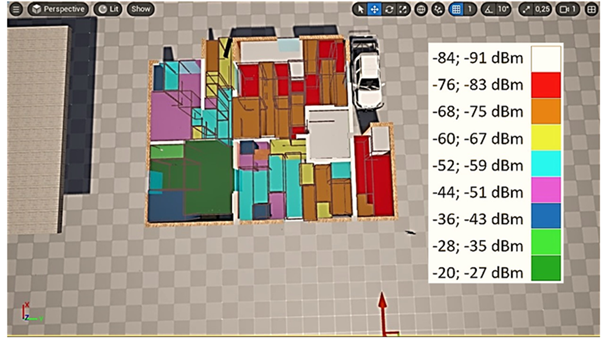Comparison of interior propagation models of the Wi-Fi network at the 5785 MHz band through RSSI measurements
Main Article Content
Abstract
This study presents a comparative analysis of the Cost231-Multi-Wall Model, the Motley-Keenan Model, the Modified Free Space Model, and the Log-Normal Shadowing Path Loss Model, applied to a 5G Wi-Fi network in an indoor analysis. The research seeks to recommend the most appropriate small-scale propagation model based on empirical measurements of signal strength. Initially, the router is located within the analysis area. Then, a detailed sketch is made in SketchUp, locating 133 points around the primary router, covering the entire indoor area of the analysis, ensuring an accurate assessment of the cellular network coverage. Subsequently, with the data collected over three campaigns, propagation losses were calculated to determine the theoretical power of each model and compare the measured power values with the theoretical power values to obtain a specific model. The four propagation models analyzed in the evaluator are based on data obtained in the range [-20 to-91] dBm. It was concluded that the Keenan-Motley propagation model offered a better fit to the measurements, presenting a value of 12.59 dB. In contrast, the Cost 231 model showed a value of 17.18 dB, the Modified Free Space model showed a value of 26.47 dB, and the Log-Normal Shadowing Path Loss model showed a value of 27.57 dB, indicating a greater discrepancy concerning the measured data. This model demonstrated greater accuracy in predicting the reception power compared to the other analysis models, adapting better to the specific characteristics of the environment. These results highlight the importance of strategically locating the router; therefore, it is recommended to locate it in a central location.
Downloads
Article Details

This work is licensed under a Creative Commons Attribution 4.0 International License.
Authors who publish in this journal agree to the following terms: Authors retain the copyright and guarantee the journal the right to be the first publication of the work, as well as, licensed under a Creative Commons Attribution License that allows others share the work with an acknowledgment of the authorship of the work and the initial publication in this journal. Authors may separately establish additional agreements for the non-exclusive distribution of the version of the work published in the journal (for example, placing it in an institutional repository or publishing it in a book), with acknowledgment of its initial publication in this journal. Authors are allowed and encouraged to disseminate their work electronically (for example, in institutional repositories or on their own website) before and during the submission process, as it may lead to productive exchanges as well as further citation earliest and oldest of published works.
How to Cite
References
[1] J. Pérez, “Impacto de las nuevas tecnologías móviles en la sociedad,” Revista UNESUM Ciencias, vol. 7, no. 1, pp. 4560, 2025. [Online]. Available: https://revistas.unesum.edu.ec/index.php/ unesumciencias/article/view/474/591
[2] Naciones Unidas, “Influencia de las tecnologías digitales,” https://www.un.org/es/un75/impact-digital-technologies, 2020, accedido: 16 de abril de 2025.
[3] S. M. Cordero, “Análisis de la calidad de señal en una red wi-fi con la herramienta netstumbler,” Umbral Científico, vol. 7, pp. 61–71, 2005. [Online]. Available: https://www.redalyc.org/pdf/304/30400708.pdf
[4] J. L. Camargo Olivares. (2009) Modelos de propagación en interiores. [Online]. Available: https://biblus.us.es/bibing/proyectos/abreproy/11761/fichero/Volumen2%252F11-Cap%C3%ADtulo6+-+Modelos+de+propagaci%C3%B3n+en+interiores.pdf
[5] Xirio Online, “COST 231,” 2025, accedido: 16 de abril de 2025. [Online]. Available: https://www.xirio-online.com/web/help/es/cost 231.htm
[6] S. P. R. Torres, and A. J. G. Meza, “Fundamentos de las comunicaciones móviles,” Universidad Tecnológica de Bolívar, Cartagena, Colombia, 2008, disponible en: https://biblioteca.utb.edu.co/notas/tesis/ 0043125.pdf.
[7] S. Sadowski and P. Spachos, “RSSI-based indoor localization with the internet of things,” IEEE Access, vol. 6, pp. 30149–30161, 2018.
[8] A. M. Al-Samman, T. Abd. Rahman, T. Al-Hadhrami, A. Daho, M. N. Hindia, M. H. Azmi, K. Dimyati, and M. Alazab, “Comparative study of indoor propagation model below and above 6 GHz for 5 G wireless networks,” Electronics, vol. 8, no. 1, p. 44, 2019. [Online]. Available: https://doi.org/10.3390/electronics8010044
[9] C. Maldonado, N. Pérez García, J. Uzcátegui, and E. Malaver, “Nuevo modelo de propagación para redes wlan operando en 2.4 ghz, en ambientes interiores,” Télématique, vol. 9, pp. 1–22, 01 2010.
[10] O. A. Guzm´an Obreg´on, S. Fern´andez, Y. Arbella, and W. Calzadilla, “Indoor propagation models in mobile communications,” 11 2010.
[11] G. Keenan and F. Motley, “A new propagation model for urban environments,” IEEE Transactions on Communications, vol. 45, no. 3, pp. 201–213, 1997.
[12] G. Molina and J. Keenan, Propagation Models and Predictions for Wireless Communications, 1st ed. New York: Springer, 2000.
[13] I. Altair Engineering, Motley-Keenan Model (MK), 2022. [Online]. Available: https://2022.help.altair.com/2022.1/winprop/topics/winprop/ user guide/propagation methods/propagation models indoor mk.htm
[14] E. C. in the Field of Scientific and T. R. (COST), “Urban transmission loss models for mobile radio in the 900 and 1800 MHz bands,” COST 231 Final Report, 1999, available online at the COST 231 project website.
[15] M. Hata, Empirical Formula for Propagation Loss in Land Mobile Radio Services. IEEE, 1980, vol. 29, no. 3.
[16] R. Ogilvie. (2024) Modelo cost. [Online]. Available: https:// www.studocu.com/latam/document/universidad-tecnologica-de-panama/ comunicaciones-i/modelo-cost/85013323
[17] E. C. in the Field of Scientific and T. R. (COST), Final Report of COST 231: Digital Mobile Communications. Brussels: COST, 1999.
[18] Huawei, “Echolife hg8546m5,” 2024, accessed: 2024-07-24. [Online]. Available: https://support.huawei.com/enterprise/es/spanish-documents/ echolife-hg8546m5-pid-23033074
[19] Huawei Technologies Co., Ltd., “Huawei HS8546V5 Smart Gateway,” https://szfibersystem.com/producto/huawei-hs8456v5/, 2020, accedido: 22 de abril de 2025

